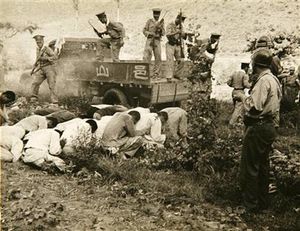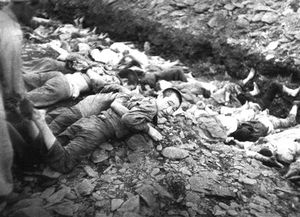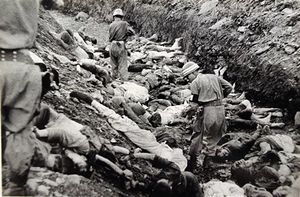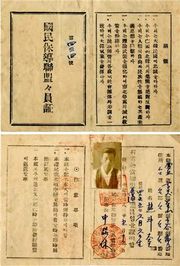مذبحة عصبة بودو
| Bodo League massacre | |
|---|---|
 Summary execution of South Korean political prisoners by the South Korean military and police at Daejeon, South Korea | |
| المكان | Korea |
| التاريخ | Summer of 1950 |
| الهدف | Communists and suspected Communist sympathizers[1] |
نوع الهجوم | Massacre |
| الوفيات | 100,000[2]–200,000[3] |
| المنفذون | South Korean anticommunists |
| الدافع | Anti-communism; fear of North Korean collaborators |
مذبحة عصبة بودو (الكورية: 보도연맹 학살사건; هانجا: 保導聯盟虐殺事件؛ إنگليزية: Bodo League massacre) كانت مذبحة و جريمة حرب ضد communists and suspected sympathizers (many of whom were civilians who had no connection with communism or communists) that occurred in the summer of 1950 during the Korean War. Estimates of the death toll vary. It has been estimated that the number of victims killed is between 100,000 and 200,000.[2] The number of Bodo League members killed in Ulsan, Cheongdo County and Kimhae alone, where the number of confirmed victims was almost exactly 4,934, was 30 to 70 percent of the press alliance members massacred and more than 100 people to more than 1,000 people were killed in each county unit respectively.[4] The massacre was wrongly blamed on the communists.[5] For four decades the South Korean government concealed this massacre. Survivors were forbidden by the government from revealing it, under suspicion of being communist sympathizers. Public revelation carried with it the threat of torture and death. During the 1990s and onwards, several corpses were excavated from mass graves, resulting in public awareness of the massacre.[6][7]
. . . . . . . . . . . . . . . . . . . . . . . . . . . . . . . . . . . . . . . . . . . . . . . . . . . . . . . . . . . . . . . . . . . . . . . . . . . . . . . . . . . . . . . . . . . . . . . . . . . . . . . . . . . . . . . . . . . . . . . . . . . . . . . . . . . . . . . . . . . . . . . . . . . . . . . . . . . . . . . . . . . . . . . .
عصبة بودو
رئيس كوريا الجنوبية سونگمان إي had about 300,000 suspected communist sympathizers or his political opponents enrolled in an official "re-education" movement known as the عصبة بودو (or National Rehabilitation and Guidance League, National Guard Alliance,[8] National Guidance Alliance[9] National Bodo League,[10] Bodo Yeonmaeng,[8] Gukmin Bodo Ryeonmaeng, 국민보도연맹, 國民保導聯盟) on the pretext of protecting them from execution.[5][8][11] عصبة بودو أنشأها مشرعون كوريون كانوا قد تعاونوا مع اليابانيين.[12] Non-communist sympathizers and others were also forced into the Bodo League to fill enlistment quotas.[10][11]
في يونيو 1949 اتهمت حكومة كوريا الجنوبية ناشطي الاستقلال بأنهم أعضاء في عصبة بودو.[8] في 1950، مباشرة قبل اندلاع الحرب الكورية، اعتقل أول رئيس لـكوريا الجنوبية، سونگمان إي، نحو 20,000 شيوعي مزعوم.[13]
الإعدامات


مفوضية الحقيقة والمصالحة
In 2008, trenches containing the bodies of children were discovered in Daejeon, South Korea, and other sites.[15][المصدر لا يؤكد ذلك][14] South Korea's Truth and Reconciliation Commission documented testimonies of those still alive and who took part in the executions, including former Daejeon prison guard Lee Joon-young.
Besides photographs of the execution trench sites, the National Archives in Washington D.C. released declassified photographs of U.S. soldiers at execution sites including Daejeon, confirming American military knowledge.[15][المصدر لا يؤكد ذلك]
Additional photographs
انظر أيضاً
الهامش
- ^ Kim 2004, p. 533.
- ^ أ ب South Korea owns up to brutal past Sydney Morning Herald
- ^ https://books.google.com.sg/books?id=zVxeBAAAQBAJ&pg=PT73#v=onepage&q&f=false
- ^ 진실화해위는 확인된 희생자 수만 4천934명으로 거의 정확하게 희생자 수가 밝혀진 울산ㆍ청도ㆍ김해 지역은 보도연맹원 가운데 30~70%가 학살됐고 각 군 단위에서 적게는 100여명, 많게는 1천여명이 살해된 것으로 추정된다고 밝혔다."진실화해위, 보도연맹원 4천934명 희생 확인(종합)" (in الكورية).
- ^ أ ب "South Korea owns up to brutal past". The Sydney Morning Herald. 2007. Retrieved 2008-12-15.
- ^ "진실화해위 "보도연맹원 4천934명 희생 확인" : 네이버 뉴스".
- ^ NEWSIS. ":: 공감언론 뉴시스통신사 ::". newsis (in الكورية). Retrieved 2017-02-15.
- ^ أ ب ت ث "Family tragedy indicative of S. Korea's remaining war wounds – Kim Gwang-ho is waiting for the government to apologize for state crimes committed against his father and grandfather". Hankyoreh. 23 January 2010. Retrieved 2010-07-22.
- ^ خطأ استشهاد: وسم
<ref>غير صحيح؛ لا نص تم توفيره للمراجع المسماةcbs-20090211 - ^ أ ب "Waiting for the truth – A missed deadline contributes to a lost history". Hankyoreh. 25 June 2007. Retrieved 2010-07-22.
- ^ أ ب Bae Ji-sook (3 February 2009). "Gov't Killed 3,400 Civilians During War". Korea Times. Retrieved 2011-07-18.
- ^ John Tirman (2011). The Deaths of Others: The Fate of Civilians in America's Wars. Oxford University Press. p. 96.
- ^ Kim 2004, p. 526.
- ^ أ ب ت Charles J. Hanley & Hyung-Jin Kim (10 July 2010). "Korea bloodbath probe ends; US escapes much blame". Associated Press. San Diego Union Tribune. Retrieved 2011-05-23.
- ^ أ ب خطأ استشهاد: وسم
<ref>غير صحيح؛ لا نص تم توفيره للمراجع المسماةFox
أعمال مذكورة
- Kim, Dong-Choon (December 2004). "Forgotten war, forgotten massacres--the Korean War (1950-1953) as licensed mass killings". Journal of Genocide Research. 6 (4). doi:10.1080/1462352042000320592.
{{cite journal}}: Invalid|ref=harv(help)
وصلات خارجية
- Mass Killings in Korea — Commission Probes Hidden History of 1950, Associated Press (Video and Documents)
- Unearthing War’s Horrors Years Later in South Korea, New York Times, 3 December 2007.
- TRCK confirms hundreds of villagers were massacred during onset of Korean War The commission advises an official state apology and will continue investigations of the National Guard Alliance through the end of the year, Hankyoreh, 17 November 2009.
- Truth commission confirms Korean War killings by soldiers and police 3,400 civilians and inmates were shot dead or drowned out of concerns they might cooperate with the People’s Army, Hankyoreh, 3 March 2009.
- CS1 الكورية-language sources (ko)
- Articles containing كورية-language text
- Articles containing Korean-language text
- Articles containing إنگليزية-language text
- مقالات ذات عبارات بحاجة لمصادر
- South Korea articles missing geocoordinate data
- All articles needing coordinates
- مذابح في كوريا الجنوبية
- مذابح ارتكبتها كوريا الجنوبية
- القمع السياسي في كوريا الجنوبية
- جرائم حرب في كوريا الجنوبية
- جرائم حرب كورية جنوبية
- فضائح عسكرية
- جرائم الحرب الكورية
- 1950 في كوريا الجنوبية
- تطهير سياسي وثقافي
- معاداة الشيوعية في كوريا الجنوبية
- الارهاب الأبيض
- قتل جماعي في 1950
- Politicides




